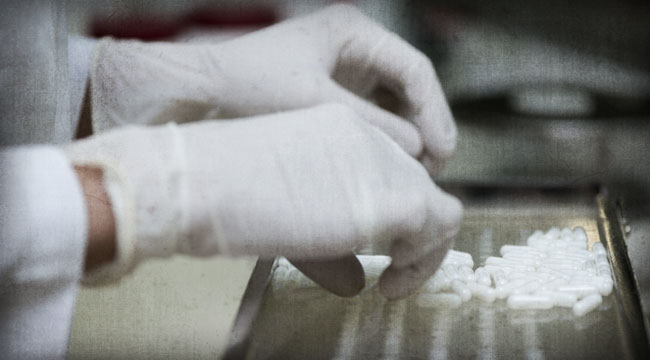The Scariest Thing You Don't Know About Generic Drugs
Karen Bartlett spent months recovering in the hospital after losing two-thirds of her skin and needing a medically induced coma.
She is now legally blind and has trouble swallowing because of scarring in her throat. She lives off disability payments… all because she took a generic drug.
In 2004, Karen’s doctor prescribed her Clinoril — an anti-inflammatory drug — for shoulder pain. When she went to fill the prescription, the pharmacy gave her the generic version of Clinoril, called sulindac. Soon after taking sulindac, she developed Stevens-Johnson syndrome (SJS) — a rare and life-threatening skin disorder caused by certain medications, infections, or cancer.
Karen sued the generic-drug maker, and in 2010, won a $21 million judgment. However, last summer, the Supreme Court overturned the ruling because of a much-debated legal point: Generic manufacturers can’t be sued.
You see, the FDA requires generic drugs to carry the exact same labeling as their name-brand counterparts (not including the brand name or trademark). All of the safety precautions, warnings, and related text must be copied exactly.
As it was, the name-brand drug did not specifically warn patients about SJS, so the generic drug didn’t either. The generic-drug maker had no further legal obligation…
The FDA is currently working on changing this rule to force generic drugs to include their own safety warnings, which would allow people to sue generic-drug makers over harmful side effects.
Regardless… Karen’s story isn’t unique. And it underscores a hidden danger of generic drugs: They aren’t as safe as you think…
Most people assume generic drugs are identical to the branded drugs they’re meant to replicate. They figure that makes them as safe as the name-brand stuff. And they’re protected if they experience serious side effects.
But none of that is correct. Generics are not identical… and you’re not safe.
Big government and big businesses aren’t looking out for the individual. It’s up to you to make the best decisions for your health.
So today, I want to empower you to make knowledgeable decisions the next time you’re at your doctor’s office or the pharmacy.
Generic drugs account for more than 80% of all prescription drugs filled in America. And that number is expected to rise over the next five years to 87%, thanks, in part, to the U.S. government.
The Obama administration is pushing the Federal Drug Administration to approve more generics to increase competition and decrease prices. Some estimates say the value of the pharmaceutical industry will soar from $359 billion in 2012 to $476 billion by 2020, due to increases in the number of people insured (including those covered by Medicaid).
Insurance companies all push the use of generics as lower-cost substitutes for brand-label drugs… Because makers of generic drugs don’t have to put all their money into research and development, they can charge less. Of course, the insurance companies receive incentives from the makers to encourage generics.
The momentum behind generics is so strong, it’s likely your pharmacist or insurance company has switched a prescription of yours to a generic alternative without you realizing it. And switching your drug to a generic — without your consent — is perfectly legal.
In theory, this makes sense…
Generics are supposed to work the same way and have the same effects as the name-brand drug. Something called “bioequivalence” means things like the dosing, strength, method of administration, and intended use should be the same.
Measuring bioequivalence is a difficult process to explain, but it is the crux of the problem. So bear with me…
Basically both drugs — the name brand and the generic — are given to patients over a certain time interval, say for 72 hours. The amount of the drug in each patient’s bloodstream is measured hourly. This is called the “plasma concentration.”
The concentrations of each patient are averaged, giving the mean concentration for that time period. This gives something we call a metabolic pattern — how the mean concentration changes over time in a set percentage of people. As long as the pattern for the generic is close enough to the brand name, it can hit the market.
But here’s the scary part: The FDA won’t release the bioequivalence studies that determine their judgment.
Worse… even if the bioequivalence is close, that doesn’t always mean the generic will act the same way as the name-brand drug. What’s advertised as the same drug with the same dosage may have anywhere from 15% less to 25% more of the drug’s activity in the body… This means the generic could be slightly more or less effective than the brand-label version.
The ingredients can also be different. The only ingredient that generics need to have in common with the name-brand drug is the active ingredient. That means all preservatives, binding materials, coatings, dyes, and flavorings are fair game. The generic-drug maker will often switch to lower-cost ingredients (another reason generics are cheaper).
This is all legal and approved by the FDA…
But these differences in inactive ingredients — called “excipients” — lead to possible side effects not found taking the brand-label drug. For example:

The FDA doesn’t test for these substances. And even if it did, around 40% of the drugs taken in America are from outside the country.
According to the U.S. Government Accountability Office, at the rate global laboratories have grown in the generic market, it would take the FDA 13 years to see every foreign laboratory just once. Don’t count on the safety or efficacy of that generic drug.
And some of the foreign laboratories have already displayed safety issues.
Ranbaxy Laboratories (owned by pharmaceutical giant Daiichi Sankyo Co.) recalled atorvastatin (the generic of Lipitor) in November 2012 when reports of possible glass particles in the capsules made their way into headlines.
Eventually, Ranbaxy’s atorvastatin made its way back onto the market. But the drug was recalled again in February 2014 when a pharmacist in the U.S. spotted a 20-mg tablet in a clearly sealed 10-mg bottle.
Last May, the manufacturer pleaded guilty to charges made by the FDA that it had filed false claims and had been producing adulterated drugs. It had to pay $500 million in fines.
One of Ranbaxy’s labs in Toansa, India just failed a January 2014 FDA investigation. In the sample preparation room, the flies were “too numerous to count,” and many windows could not be shut. A refrigerator with samples had filled with water and leaked onto the floor, as well. Workers also did not run proper screening tests for sample quality. The FDA prohibited the plant from producing and distributing drugs.
Unfortunately, dozens of labs have safety issues. You can see a full list of labs that haven’t passed FDA inspection here.
Don’t get me wrong… not all generics are bad. But I believe in transparency and empowering consumers.
Remember… generic-drug makers CANNOT be sued if you have a reaction.
Before you start using a generic, ask your doctor or pharmacist some specific questions…
If you are on a blood thinner, ask about how often you should get your blood checked. Make sure to ask if you should get it rechecked when/if your prescription gets changed. The answer should be yes.
Do your research before you harm yourself. Remember… generic-drug makers CANNOT be sued if you have a reaction. They are required to copy the label verbatim from the original drug. Watchdog groups and online forums can help if you start feeling like the drug is causing problems.
Certain kinds of drugs require delicate and tight therapeutic dosing regimens. With things like mental illness, epilepsy, and blood thinning – ask your doctor about generics and which ones are the best substitutes for your name-brand drug.
Once you start the generic, make sure you monitor your symptoms. Any recurrence of symptoms could mean the generic isn’t working. If that’s the case, ask your doctor if you can switch to the brand name.
Also, keep a log of your medications. Every time you get a refill, make note of the name, brand, distributor, color, and medication dose. Give this journal to your doctor/spouse/kids – everyone. This is a simple way to keep track of your medications, and it can save your life if you’re ever in the hospital.
If you want the brand name, some insurance companies will make you pay a higher co-pay or claim the drug is not approved and refuse to pay for any portion of it – making you cover the full cost.
If you’re worried about the added cost, there are ways to save money on prescriptions.
An “authorized generic” is a generic-label version sold by the brand-label manufacturer. It’s a lower-cost version of the exact same drug.
The same company makes it with the exact same ingredients. This allows the manufacturer to corner the market on the generic form of the drug, pushing out other potential generics. For consumers, it means getting the exact same drug as the brand-label drug… avoiding any variances that come with using the generics from a different manufacturer.
The FDA maintains a list of authorized generics. You can see it here.
Another way to save money… Take a double dosage of your medicine every other day. So instead of taking 5 mg a day, take 10 mg every other day. Since a 90-day supply of 10-mg pills costs the same as the 5 mg, you’d save 50% instantly on your drugs. Just check with your doctor to see if this could work, as some medications work best taken every day, regardless of the amount.
Another way to save is with coupons. Like other consumer-product providers, drug companies offer coupons. The coupons are distributed to doctors and pharmacists. Not all companies provide coupons. But feel free to call up your doctor or pharmacist and ask if any coupons are available for your prescriptions.
You can also find printable coupons online: www.GoodRx.com and www.RxPharmacyCoupons.com are good resources.
You can also buy your drugs in bulk. Buying a 90-day supply of your medications can save you up to 40%, versus buying your medication every month. The simplest way to do this is to ask your doctor to write out a prescription for a 90-day supply, with multiple refills as necessary.
At a Walgreens in Baltimore, we found that a 90-day supply of Lipitor costs $57.10 versus $24.70 for a 30-day supply. This could save nearly $20 per refill. Before you buy in bulk, check how soon the drug will expire.
Again, I’m not against all generics. But it is important to know the possible dangers when taking a generic drug. Always keep a list of what you’re taking and talk to your doctor if you have concerns.
Here’s to our health, wealth, and a great retirement,
Doc Eifrig
for The Daily Reckoning
Ed. Note: Tips to keep you safe… Natural health cures that don’t require you to get a doctor’s prescription… Healthcare alternatives that save you money and keep you healthy… These are the things that Laissez Faire Today brings to you. Click here and subscribe for FREE so you don’t miss out on any future tips or ideas..
Article posted on Laissez Faire Today



Comments: